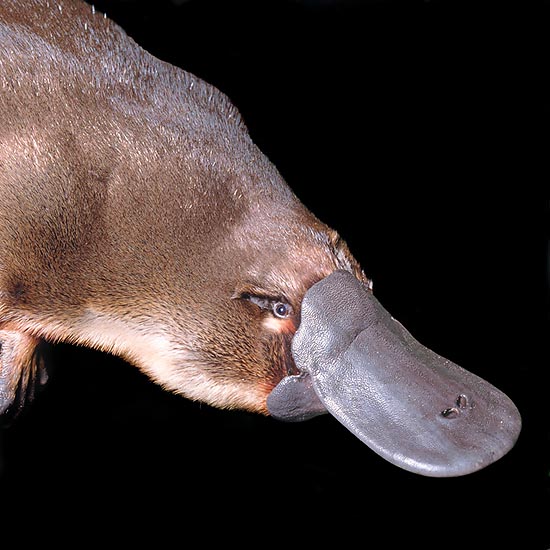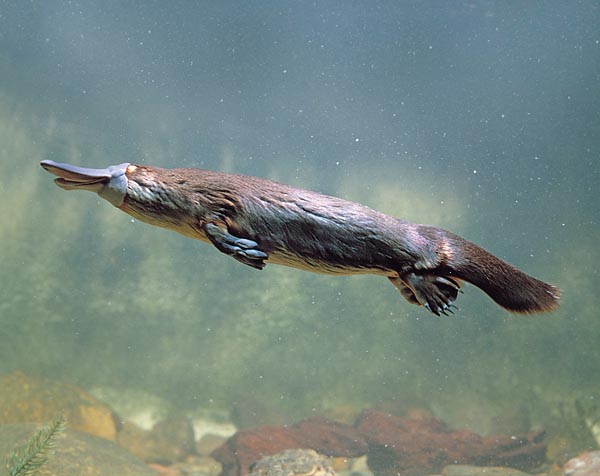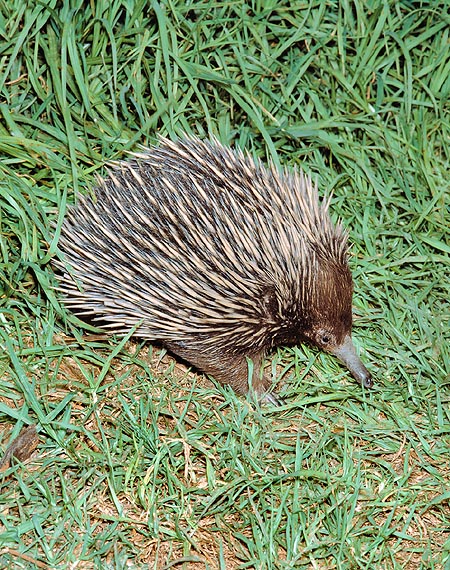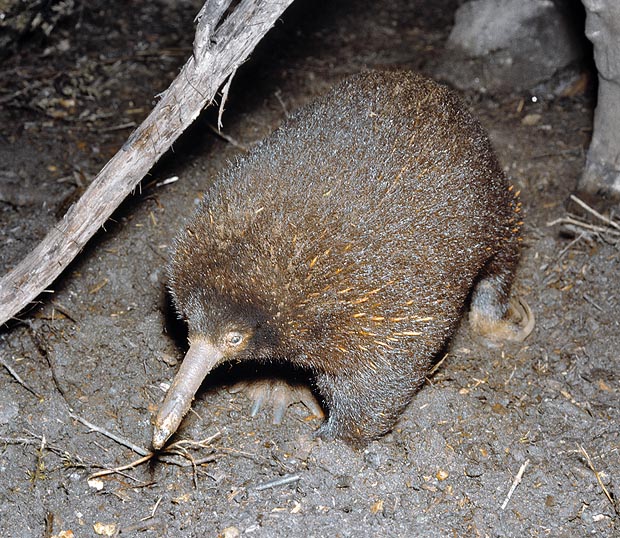
Text © DrSc Giuliano Russini – Biologist Zoologist

English translation by Mario Beltramini

The Monotremes order includes the here shown platypus and the echidnae © Giuseppe Mazza
The order of the Monotremes (Monotremata C. L. Bonaparte, 1837) afferent to the infraclass of the Prototherians (Prototheria), like that of the Marsupials (Marsupialia), afferent to the infraclass of the Matatherians (Metatheria), include some of the most interesting and original mammals for the zoologist. These animals are so much different from the common Eutherians (Eutheria), that there are still many, since their discovery, the news and the original information which characterize them.
With the exception of the opossums and of the caenolestes of the New World, the monotremes and the marsupials are found only in the Australian region and in some nearby islands, such as the Tasmania and the New Guinea. The discoverers and the first explorers of the Australian coasts saw very few mammals during their first explorations; to say the truth, they had not gone too far inland, but, nevertheless, what they relate in their diaries and documents is not much.
Abel Tasman, who in the distant 1642 visited the southern coast of Tasmania (the name to this island was later given in his honour), calling it “Van Diemen Island”, after the name of the governor of Batavia, did notice “traces of wild animals, not differing from those left by the claws of a tiger of by some similar creature..”; it is not excluded that he and his crew, had rightly met the traces left by the Tasmanian devil (Sarcophilus harrisii).
Quite strangely, for quite a long time, the study of the Australian fauna did not arouse great interest among the zoologists, if compared to the interest the botanists did show, on the contrary, towards its flora. This actually depended from the big size of the Australian continent, in respect to the small one of the English and Dutch colonies which were shaping up in this immense land, what rendered difficult the meeting with this original fauna. Throughout the XVII and then also the XVIII centuries, the areas conquered by the settlers were utilized for building there farms or penal settlements; only few explorers and biologists tried to provide information about the local flora and fauna, but whilst the first was more accessible and easier to be studied, the second was almost a mystery. The biologist William Dampier, during the first expedition he did in 1688 in Australia, landed on the northern coast and related, he too, of never having seen any animal, but some traces which appeared to be similar to those of a big mastiff.
Later on, in 1699, he visited again this continent for mapping the “Shark Bay” on the western coast; this time, thanks to his diaries and copybooks, he informs us that he met only some types of procyonids, different from those present in the Western Indies, especially regarding the legs. As a matter of fact, the scientist tells us that the forelimbs were very short, but they did use them for jumping; about one month it would seem that he met some very slim wild canids, almost skin and bones. Probably, the animals described were the striated hare kangaroos and the dingoes. The legendary Captain Cook, in 1770, did sail along the whole eastern coast of Australia, from South to north, encountering kangaroos, opossums and dingoes. During the XVIII century some biologists, such as John White, did produce beautiful engravings on paper, of fauna and flora of those exotic countries, as it can be seen into the opus entitled “New South Wales”, dated November 18th, 1788.

Swimming male of Ornithorynchus anatinus. Note the poisonous spur © Giuseppe Mazza
During the XIX century, other works were “Mammals of Australia”; 1871, by J.L.G. Krefft, for some years curator of the natural history museum of Sydney; these were followed, by the beginning of the XX century, by works of biologists of several nationalities, like that one by the French A.S. Le Souef, “The wild animals of Australasia” and by the Australian H. Burrell, with “The furred animals of Australasia”.
At this stage the zoologists’ interest for the Australian wild fauna did cease, or at least greatly diminished, as they were convinced that all what was to be discovered about, had rightly been already discovered and amply described. This sort of middle age of the Australian mammals’ fauna ended at the end of the second WW, when, actually, the Australian biologists realized that the so far described species of mammals were not at all the only ones of the continent and that their biology had been only partially and superficially studied. Therefore, the Wildlife Research section of the Commonwealth Scientific and Industrial Research Organization was formed by the Australian zoologists; furthermore, the museums and the Australian zoological gardens united for studying in the details the known wild fauna and discover any new, if any. At this point, the biological literature (which, till then had a heavy absence of texts about the Australian mammals) was invaded by an explosive stream of information about these animals. Till now, even if the information have greatly increased, there is still a lot of study awaiting the biologists, in the field as well as in controlled locations, for instance in the zoological gardens, about all species of all the known Australian mammals.
The taxonomical biologists have the tendency to divide the class of the Mammals (Mammalia), acknowledging the anatomical and reproductive physiological differences as well as the phylogenetic distances, into three infraclasses (till the seventies of the last century, they were considered as subclasses). These are, the infraclass of the Prototherians (Prototheria), to which leads the order of the Monotremes (Monotremata), the infraclass of the Metatherians (Metatheria), to which belong that of the Marsupials (Marsupialia) and the infraclass of the Eutherians (Eutheria), also called good beasts or placental or placentate mammals, to which lead most of the mammals, among which, the primates and the human being. Here we shall describe the monotremes only. The Monotremata represent the only known order of the infraclass of the Prototherians (Prototheria); the term monotremes comes from the Greek and means a single hole or a single exit. This definition originates from an anatomical adaptation present in the members of this order, where is present only one hole, called “cloaca”, where converge the urogenital and defecatory ducts. For this reason, the defecation, the urination and the reproduction, including, as we shall see, the egg deposition, as they are oviparous, takes place by means of this. This recalls a phylogenetic similarity with the reptilians and the birds, and reveals a certain ancientness of the group. These mammals, rightly, even if showing extremely specialized adaptations towards the ambient and the style of life, are primitive, as they conserve some typical characteristics of the reptilians.

Tachyglossus aculeatus looks like a hedgehog but lays eggs © Giuseppe Mazza
The reptilian character which differentiates them more concretely from all other mammals is the fact of being oviparous, instead of viviparous as all others; this is correlated to the structure of the reproductive apparatus, which is quite similar to that of the reptiles and of the birds themselves.
Many other particulars of the anatomy of these animals are closer to those of the reptiles, than to those of the mammals; the most surprising is that of the “thoracic girdle” which keeps the coracoid and interclavicular bones separated, whilst the epipubic bones are connected to the “pelvic girdle”.
Likewise primitive are several other points of the anatomy of the skeleton, and also those of the soft tissues; these have been studied by several biologists and the findings have been collected in opera of encyclopaedic character, like the “Traité de Zoologie” treated by the celebrated French zoological biologist P.P. Grassé, where they are admirably presented.
On the other hand, the brain of the monotremes is remarkably different from that of the reptilians and very much resembles, on the contrary, to that of the metatherians; the prosencephalon or “cerebrum” (the anterior division of the central nervoussystem), especially in the echidna (the species of the genus Tachyglossus, as well as those of the genus Zaglossus), is fairly big, even if not having the corpus callosum, that is, that big connection structure between the two hemispheres typical in the placentates.
As the zoological biologist Woof Jones points out, the monotremes are well equipped of cerebral cortex, but their brain has not yet perfect connections.
The monotremes have not left so much back behind them the ancestral reptilians characters, as have on the contrary done the other mammals; they do not represent, in any case, an intermediate evolution stage of the metatherians and the eutherians, but a parallel evolution line which has prematurely detached from the original strain of the insectivorous reptilians. Recent studies, done on the fossil remains of mammals with primitive reptilian characters, suggest the hypothesis the strain of the monotremes has broken away from that which originated also the other mammals, about 200 million of years ago, in the Triassic, Mesozoic or Secondary era, at the level of reptile organization.
These researches have not been done on monotremes’ fossils, of which nothing going back before the Pleistocene, Quaternary, about two million of years ago, has been found, but on the fossils of Triconodonts (Triconodonta). The remains of these animals, which conserved like fossils, are usually their tiny teeth; modern methods of separation of small fossils from their matrix have revealed some fragments of bone measuring in total only a few millimetres and which, after careful and conscientious examination, have furnished the information given before.
The researches suggest also that there are no proofs sustaining the wrong, but widely spread, opinion, after which in the Tertiary there should have been a violent evolutive explosion amongst the mammals. The first satisfying fossils of eutherian mammals appear in the Palaeocene, Cainozoic, when almost all the modern orders, and many of the extinct ones, had already differentiated: but the mammals had had a hundred of million of years’ time form differentiating, and therefore there is no reason for thinking that their evolution has accelerated the pace by the beginning of the Tertiary, about eighty million of years ago.

Zaglossus bruijni. Like reptilians and birds has one hole for both urogenital and digestive systems © G. Mazza
The absence of fossil documents deprives us of knowing the evolution of the mammals in the Mesozoic, but the huge variety of forms present by the end of that era, shows that there was no discontinuity at all.
The extant monotremes are geographically limited to Australia, Tasman Island and New Guinea included; therefore, the Pleistocene forms belonging to extant forms and consequently not very ancient and which should be, more correctly, defined as “sub-fossil”, have been found in Australia only. There are no elements to establish if once the monotremes were more widely distributed (as was the case, for instance, of the triconodonts, known also in England and in North America), or is, on the contrary, they were always confined to the Australian region.
The monotremes have the two diagnostic characters of the mammals: they have hairs and mammary glands. Due to the so ancient separation of their line from that of the other mammals, we might think that the mammals have evolved twice from their reptile ancestors.
On the other hand, the size of the brain of the echidna and the resemblance between the encephalon of the monotremes with that of the metatherians, seem to show a closer relation than what that hypothesis should entail.
A recent study on the quantity of DNA present in the somatic cells of the monotremes has shown also that these animals have an affinity closer with the other mammals than with the reptilians: this has been confirmed by measuring the total area occupied by their chromosomes. The DNA contents in the monotremes stands between the 93 and the 98% of that of the eutherian mammals: that of the only examined marsupials, genera Potorus and Didelphis, is of the 81 and 94%. In comparison, in the birds it is of about the 50%, in the serpents and the lizards of the 60-67%, in the crocodiles and the chelonians, of the 80-89%.
When evaluating these findings, it is to be kept in mind, however, that the question of the DNA quantity becomes more and more complicated through a polyploidy of various kinds. Studies at the electronic microscope, done on echidna’s spermatozoa, have also shown that, even if being the shape of these germinal elements superficially similar to that of the spermatozoa of a reptilian, the ultrastructure is manly the typical one of the mammals. The discovery of a greater number of fossils might give us a greater number of information; in the meanwhile, there is no doubt that there is still much to be learnt from the observation of the extant forms.
The order of the Monotremes (Monotremata) is in its turn subdivided into two families: the Tachyglossids (Tachyglossidae) that is the echidnas, and the Ornithorhynchids (Ornithorhynchidae), which count only the well known Platypus (Ornithorhynchus anatinus).
